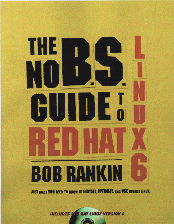

 |
 |

No B.S., really? was my first question when picking up this book. After reading it, I can say that the writing is concise and in places even terser than an uninformed reader might desire. Overall, I think it succeeded.
The book contains 15 chapters and some useful appendices. Chapter 1, ``Installing LINUX on your PC'', starts off by assuming the user has a Microsoft OS on his computer, has a net connection and web browser, and wants to run more than one OS on the computer. The instructions are fine if one does not run into any problems, but if one does, the recommendation is to go to a web site or Usenet newsgroup to read and ask questions. How many MS users have the patience to do that? Other chapters are as follows:
Appendix A lists all software packages on the Red Hat 6.0 CD-ROM included with the book. One particularly good feature is an indication of how much disk space each will take. This could be quite useful for someone trying to put together a fun setup on a small hard drive. Appendix B contains ``The GNU General Public License''. Appendix C, ``DOS and UNIX Equivalencies'', lists a couple of dozen parallel commands with examples of usage.
I do have a few criticisms of this book. In Chapter 1, several examples of hard drive partitions and/or CD-ROM drives referred to by their /dev file names are given, but I don't believe the average Microsoft software user could configure a system with just the /dev information in this book. It was a serious omission not to list the conventions for IDE, SCSI, etc. Luckily, the CD-ROM installation procedure may help the uninitiated. Another problem was the statement ``...but you can't really hurt anything if the installation isn't successful....'' Without qualifying that your original system absolutely must be backed up for this to be true so that one can restore if necessary, I don't understand how using DOS' fdisk can't help hurting something. It would have been nice for the author to guide the user through fips and not just fdisk.
I also had a problem with the facetious sentence in Chapter 13:
If you think you did everything right and the mouse still doesn't work, sometimes whacking it on a hard surface while shouting, ``You stupid mouse!'', works wonders.In my experience, the ``wonder'' is the mouse ball mashes a sensor and one must then obtain a new mouse.
Although Rankin emphasizes using GNOME and describes how quite well in several chapters, he does not neglect the command-line interface. Particularly good were chapters 2, 4, 7, 8, 10 (the description of Pine), 11 and 14 (the detailed explanation of RPM).
For those whom I think of as typical Microsoft users, I recommend they follow the step-by-step installation procedures in Linux for Dummies, 2nd Edition, then move on to this book after they have a working Linux system. The installation process described there will work with the CD-ROM that comes with this book as well. For the Microsoft user who is willing to read first and needs little guidance to solve problems easily, I also recommend it. For someone who has already installed Red Hat 6.0 Linux and wants to learn more about its new capabilities, I wholeheartedly recommend this book.
Harvey Friedman can be reached via e-mail at fnharvey@u.washington.edu.